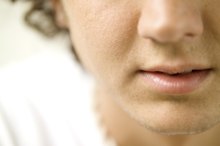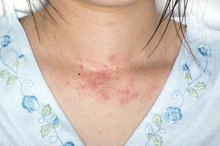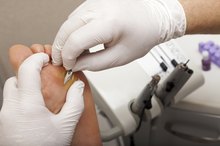What does fact checked mean?
At Healthfully, we strive to deliver objective content that is accurate and up-to-date. Our team periodically reviews articles in order to ensure content quality. The sources cited below consist of evidence from peer-reviewed journals, prominent medical organizations, academic associations, and government data.
- PubMed.gov: Tazarotene versus tretinoin or adapalene in the treatment of acne vulgaris
- PubMed.gov: Tazarotene versus tretinoin or adapalene in the treatment of acne vulgaris
- MayoClinic.com: Tazarotene (Topical Route)
The information contained on this site is for informational purposes only, and should not be used as a substitute for the advice of a professional health care provider. Please check with the appropriate physician regarding health questions and concerns. Although we strive to deliver accurate and up-to-date information, no guarantee to that effect is made.
Retin-A Vs. Tazorac
Tazorac and Retin-A are both vitamin A-based drugs called retinoids. Retin-A is the name brand of a drug called tretinoin. Tazorac is the name brand for a drug called tazarotene 1. Retinoids can speed skin-cell turnover and boost collagen production.
Forms
Tazorac comes in a gel or a cream. Retin-A comes in cream, gel or liquid form. Both Tazorac and Retin-A require a doctor’s prescription.
Acne
Glycolic Acid vs. Retin-A
Learn More
Both Retin-A and Tazorac can be used to treat acne. They both work by keeping pores clear, according to the Mayo Clinic. Many people who use Retin-A see an improvement in their acne in four to six weeks. Optimal benefits are usually seen after three months, according to Emory College in Atlanta, Georgia. People using Tazorac will see improvement in six to eight weeks, according to acneguide.com.
- Both Retin-A and Tazorac can be used to treat acne.
- People using Tazorac will see improvement in six to eight weeks, according to acneguide.com.
Photodamage
Both of these retinoids are used to treat photodamage including brown spots, fine wrinkles, hyperpigmentation, pore size and poor skin elasticity. With Retin-A, expect improvement after three to six months of regular use, and best results between six and 12 months. With Tazorac, people should see improvement in six to eight weeks of regular use. Continued use after this point will lead to more improvement, according to acneguide.com.
- Both of these retinoids are used to treat photodamage including brown spots, fine wrinkles, hyperpigmentation, pore size and poor skin elasticity.
- With Tazorac, people should see improvement in six to eight weeks of regular use.
Other Conditions
Retin-A & Pores
Learn More
Tazorac can be used to treat psoriasis, according to the Mayo Clinic. The drug has anti-inflammatory properties, according to acneguide.com. Retin-A can be used to treat a skin disorder characterized by small, red bumps called keratosis follicularis, as well as flat warts.
Side Effects
Both of the drugs can cause a person’s skin to be sensitive to the sun, severe dryness of the skin, redness, peeling skin and skin color changes. Both also can cause an initial acne flare-up that usually dissipates with further use, according to the Mayo Clinic and acneguide.com. Other side effects with Tazorac can include deep lines or grooves in the skin and pain or swelling of the skin, according to the Mayo Clinic. Neither Tazorac nor Retin-A should be used by pregnant women.
- Both of the drugs can cause a person’s skin to be sensitive to the sun, severe dryness of the skin, redness, peeling skin and skin color changes.
- Other side effects with Tazorac can include deep lines or grooves in the skin and pain or swelling of the skin, according to the Mayo Clinic.
Effectiveness
A study published in the August 2000, Journal of the American Academy of Dermatology concluded that applying Tazorac once a day is more effective than a daily application of Retin-A in reducing papules and open acne skin bumps. The drugs appeared equally effective against closed acne skin bumps, according to the study. The study also concluded that the drugs are tolerated equally well by people.
Related Articles
References
- PubMed.gov: Tazarotene versus tretinoin or adapalene in the treatment of acne vulgaris
- MayoClinic.com: Tazarotene (Topical Route)
- Khalil S, Bardawil T, Stephan C, et al. Retinoids: a journey from the molecular structures and mechanisms of action to clinical uses in dermatology and adverse effects. J Dermatolog Treat. 2017;28(8):684-696. doi:10.1080/09546634.2017.1309349
- Heath MS, Sahni DR, Curry ZA, Feldman SR. Pharmacokinetics of tazarotene and acitretin in psoriasis. Expert Opin Drug Metab Toxicol. 2018;14(9):919-927. doi:10.1080/17425255.2018.1515198
- Kim WB, Jerome D, Yeung J. Diagnosis and management of psoriasis. Can Fam Physician. 2017;63(4):278-285.
- Torsekar R, Gautam MM. Topical Therapies in Psoriasis. Indian Dermatol Online J. 2017;8(4):235-245. doi:10.4103/2229-5178.209622
- PDR. Tazarotene Drug Summary. 2020.
- Sarkar, R., Chugh, S. Garg, V. Acitretin in dermatology. Indian Journal of Dermatology, Venereology, and Leprology, 2013;79(6), 759. doi:10.4103/0378-6323.120721
- PDR. Soriatane. 2020.
- FDA. Soriatane (acitretin) capsules. 2020.
- Mehta, B. and Amladi, S. Evaluation of topical 0/1% tazarotene cream in the treatment of palmoplantar psoriasis: An observer-blinded randomized controlled study. Indian J Dermatol. 2011 Jan-Feb;56(1):40–43. doi:10.4103/0019-5154.77550
- U.S. Food and Drug Administration. Highlights of Prescribing Information: Tazorac (tazarotene) gel, 0.05% and 0.1%, for topical use. Silver Spring, Maryland; revised April 2018.
Resources
Writer Bio
Linda Tarr Kent is a reporter and editor with more than 20 years experience at Gannett Company Inc., The McClatchy Company, Sound Publishing Inc., Mach Publishing, MomFit The Movement and other companies. Her area of expertise is health and fitness. She is a Bosu fitness and stand-up paddle surfing instructor. Kent holds a bachelor's degree in journalism from Washington State University.









